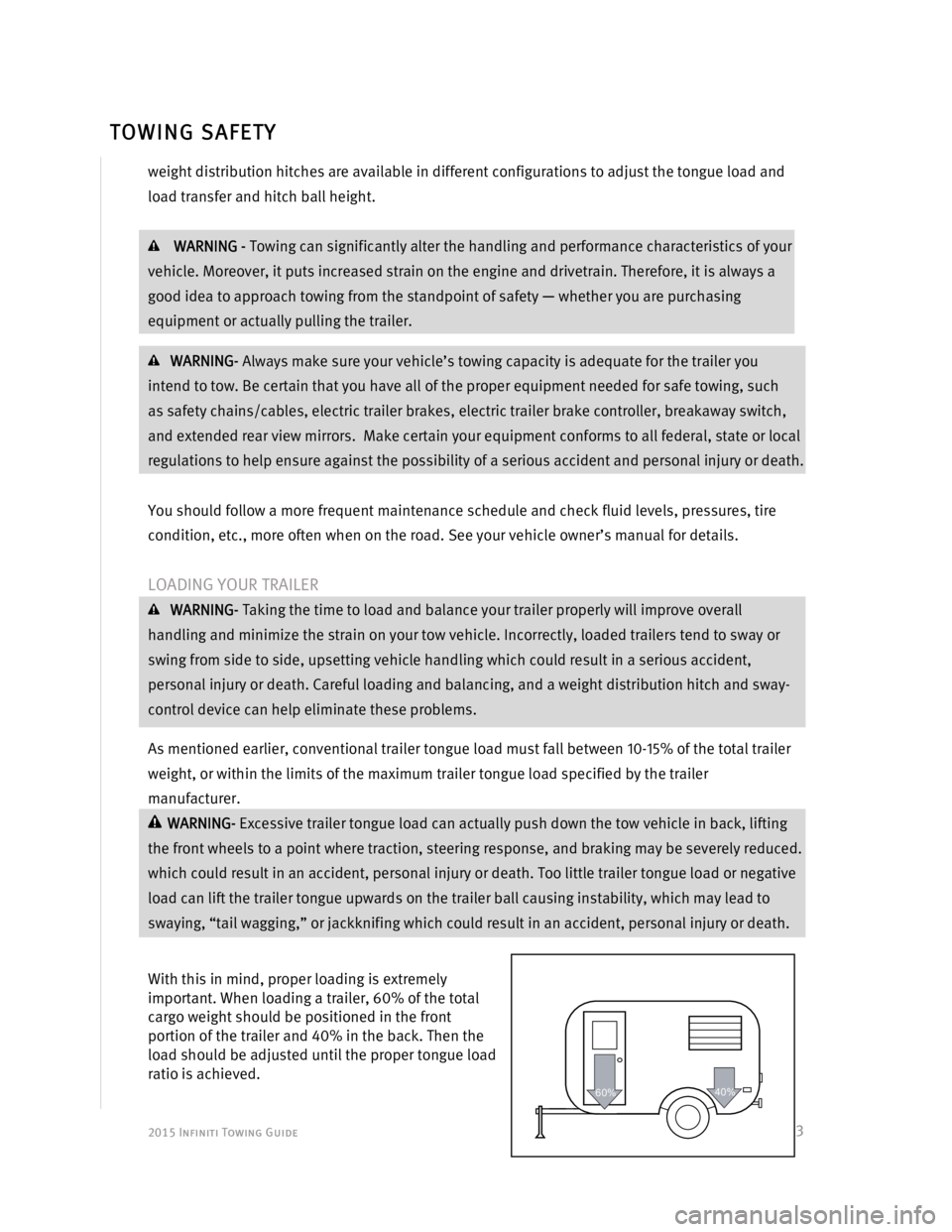brake fluid INFINITI Q50 2015 Towing Guide
[x] Cancel search | Manufacturer: INFINITI, Model Year: 2015, Model line: Q50, Model: INFINITI Q50 2015Pages: 25, PDF Size: 0.42 MB
Page 14 of 25

2015 Infiniti Towing Guide
13
weight distribution hitches are available in different configurations to adjust the tongue load and
load transfer and hitch ball height.
WARNING - Towing can significantly alter the handling and performance characteristics of your
vehicle. Moreover, it puts increased strain on the engine and drivetrain. Therefore, it is always a
good idea to approach towing from the standpoint of safety — whether you are purchasing
equipment or actually pulling the trailer.
WARNING- Always make sure your vehicle’s towing capacity is adequate for the trailer you
intend to tow. Be certain that you have all of the proper equipment needed for safe towing, such
as safety chains/cables, electric trailer brakes, electric trailer brake controller, breakaway switch,
and extended rear view mirrors. Make certain your equipment conforms to all federal, state or local
regulations to help ensure against the possibility of a serious accident and personal injury or death.
You should follow a more frequent maintenance schedule and check fluid levels, pressures, tire
condition, etc., more often when on the road. See your vehicle owner’s manual for details.
LOADING YOUR TRAILER
WARNING- Taking the time to load and balance your trailer properly will improve overall
handling and minimize the strain on your tow vehicle. Incorrectly, loaded trailers tend to sway or
swing from side to side, upsetting vehicle handling which could result in a serious accident,
personal injury or death. Careful loading and balancing, and a weight distribution hitch and sway-
control device can help eliminate these problems.
As mentioned earlier, conventional trailer tongue load must fall between 10-15% of the total trailer
weight, or within the limits of the maximum trailer tongue load specified by the trailer
manufacturer.
WARNING- Excessive trailer tongue load can actually push down the tow vehicle in back, lifting
the front wheels to a point where traction, steering response, and braking may be severely reduced.
which could result in an accident, personal injury or death. Too little trailer tongue load or negative
load can lift the trailer tongue upwards on the trailer ball causing instability, which may lead to
swaying, “tail wagging,” or jackknifing which could result in an accident, personal injury or death.
With this in mind, proper loading is extremely
important. When loading a trailer, 60% of the total
cargo weight should be positioned in the front
portion of the trailer and 40% in the back. Then the
load should be adjusted until the proper tongue load
ratio is achieved.
60%40%
TOWING SAFETY
Page 18 of 25

2015 Infiniti Towing Guide
17
Of course, backing up should be done only at very slow speeds. For large trailers that obstruct your
rearward vision, have someone outside the vehicle act as a “spotter” to guide you along.
WARNING- Do not use the Back-up Collision Intervention system (BCI) when towing a trailer. The
BCI system cannot function properly when objects are obstructing the radar sensor beams.
PARK SMART
A tow vehicle and trailer can be an unwieldy combination in a small area, so always try to park
where you will have a relatively easy time maneuvering. Once parked, always block the wheels on
both the tow vehicle and the trailer.
Parking on a slope is not recommended. If, however, you must park on a slope and your vehicle is
equipped with an automatic transmission, there are some precautions you should take:
Turn the wheels of the tow vehicle towards the side of the road away from the center of the road,
and apply the parking brake and only then move the gear lever into PARK.
Next, have someone block the wheels once the tow vehicle and trailer are in position and are
being held by the vehicle’s brake.
CAUTION-If you move the lever into PARK before blocking the wheels and applying the parking
brake, it may be difficult to later shift out of PARK. Transmission damage may also occur.
PASS CAREFULLY
As mentioned in the introduction to this section, because of the added weight of the trailer,
acceleration capability is reduced and you will require a longer distance to pass another vehicle. Be
certain you have sufficient time and space to pass safely.
WARNING- Never attempt to pass on hills or when going around curves. Doing so could cause a
loss of vehicle control and result in accident, property damage or personal injury. Because the
trailer does not follow the exact path as the tow vehicle on turns, safely passing and cornering
while towing takes considerably more distance and turning space than normal. Be certain you
have sufficient time and space to pass safely, remember, the length of the trailer must also pass
the other vehicle before you can safely change lanes.
HILLS – UPGRADES
If your vehicle is equipped with an automatic transmission, it is designed to select automatically
the correct gear for the best towing comfort and performance as the incline increases. To maintain
speed or avoid up and down shifts, manually shift to a lower gear as needed.
The added weight of a trailer places an increased load on the engine and cooling system, so
monitor your coolant temperature gauge and automatic transmission fluid temperature gauge (if